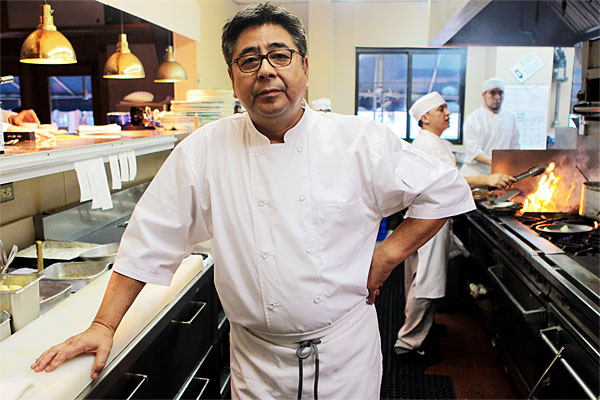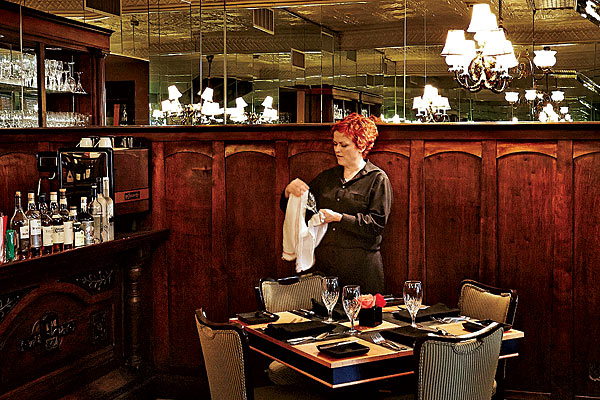
Photo: Antonio James/Chicago Tribune
Chef Yoshi Katsumura in the kitchen of his restaurant, Yoshi’s Café
When a restaurant lasts 10 years, it is to be congratulated. After 20, it is to be commemorated. If by some miracle a restaurant survives for 30 years in this difficult business, the only thing left to do is study it.
Yoshi’s Café has thrived on the same Lake View corner for 31 years; Tallgrass has held court in a 19th-century Victorian mansion in the far southwestern suburbs for 32. Both are idiosyncratic, personality-driven spots that have remained relevant by changing when they needed to, doubling down when the mood struck, and gathering the kind of loyal followings any restaurateur would kill for. But have they become simple nostalgia acts?
THE SKINNY
YOSHI’S CAFÉ 3257 N. Halsted St., 773-248-6160
FYI Yoshi’s was the first restaurant in Chicago to serve fresh fugu, Japan’s infamous pufferfish.
TAB $40 to $50
HOURS Dinner Tue. to Sun., brunch Sun.
Tab does not include alcohol, tax, or tip.
It’s only a matter of time before the corner of Halsted and Aldine has one of those honorary street signs for Yoshi Katsumura. The ebullient chef-partner has been the unofficial mayor of Boystown for years, with his wife, Nobuko, as his faithful chief of staff. They seem to greet at least half the patrons who enter their breezy bistro with hugs.
Even if you don’t know the couple personally, it’s natural to feel a bond with their restaurant and its trajectory, which mirrors Chicago’s growth—and growing pains—as a major restaurant scene. For a time in the 1980s, Yoshi’s was upscale and ahead of the curve, changing its eclectic menu daily and importing fish from Japan. Then, as the interest in French-Asian fusion that Katsumura pioneered devolved into overwrought cliché, Yoshi’s reinvented itself as a neighborhood café with lower prices and lighter fare. The restaurant didn’t just fall off the radar; it had no apparent interest in the radar.
These days, when no one much cares whether Yoshi’s is trendy, it’s no coincidence that the dishes hit their marks. Under a crispy Parmesan “dome,” a perfect al dente Japanese kabocha pumpkin raviolo floats in a goat cheese cream sauce; a delicate soft-shell crab tempura nestles with grilled shishito peppers and a creamy aïoli of miso, yuzu, and honey. Both starters allow Katsumura to give diners what they want without forfeiting his patented creativity. And when he plays things straight, as with a traditional duck liver mousse pâté with toast points, cornichons, and Dijon mustard, it’s pure pleasure.
Katsumura’s easy confidence means you might take some of the magic for granted. A stunning whole American red snapper has been deboned, head and tail intact, then dusted with flour, fried in canola oil, topped with cilantro and sautéed green beans, and bottomed with spicy hon-shimeji mushroom rice. It’s a wondrous specimen, crisp and fleshy, and the kitchen has painted its skin with homemade hoisin sauce. Then there’s Cornish game hen, a menu item I have always instinctively ignored. Here the snubbed bird gets glazed with honey and whole-grain mustard, oven-roasted until golden and juicy, ringed with a guajillo chili mole, and served with delicate sautéed Brussels sprout leaves and smooth garlic mashed potatoes. It demands attention.
Other times, the attention comes for the wrong reasons—stale bread, misguided desserts (such as a grainy chestnut mont blanc), and a neglected wine list. And Katsumura continues to periodically go overboard with the mad scientist shtick. His latest burger (a version of which I once named among Chicago’s best) is a wet mess involving wagyu beef, Asian pear jam, tomato-pickle aïoli, barbecue sauce, truffle oil, and a giant panko-crusted fried green tomato. At least the french fries were good.
Servers, ever confident and genial, charge the air with such cheer that it’s contagious. At the end of one meal, I almost embraced my waiter; few restaurants come by such camaraderie this naturally. After 31 years, Yoshi’s is less like an old flame than a dynamic lifelong companion—a kindred spirit you love despite various shortcomings.
* * *

Photo: Anna Knott
Tallgrass
Tallgrass is equally lovable, if more unpredictable. Its chef-partner, Bob Burcenski, a painter and former organist at First Presbyterian in Joliet, may have generated more ideas than any Chicago-area chef working today. Some are good, some self-indulgent, and some truly inspired. (Tallgrass’s current rating in this publication is three stars, but over the years, it’s ranged between one and half to three and a half.)
Lately, influenced by the futurist author Ray Kurzweil, Burcenski goes beyond the usual organic-sustainable ethos into what he calls “transcendent” cuisine: low in carbohydrates, cholesterol, and calories and high in Omega-3 oils. It’s an admirable mission and another stage in the evolution of a fascinating restaurant.
THE SKINNY
TALLGRASS 1006 S. State St., Lockport, 815-838-5566
FYI The maître d’ asks over the phone if you need directions, as though smartphones had never been invented.
TAB $50 to $60
HOURS Dinner Wed. to Sun.
Tab does not include alcohol, tax, or tip.
You still ring the buzzer of the Victorian mansion’s subterranean door and still dine with a mature crowd under the original pressed-tin ceiling and gas chandeliers, but many of the dishes, which diners arrange in three- to seven-course meals, have lightened up without sacrificing flavor.
Burcenski gives three plump flash-fried scallops a dash of walnut oil, a distinctive cauliflower sauce, and a sprinkle of smoked almonds. Flavors pop even more during the vegetable course, when he pairs roasted asparagus and endives with a red pepper panna cotta, flatbread, and feta. You won’t miss butter when it’s swapped out for a little punchy chive extra virgin olive oil. The highlight, three-cheese ravioli with English peas, mint pesto, and lime crème fraîche, is perfectly balanced and indelible.
Tallgrass can overcompensate with enormous portions—fine if you’re getting three courses but slightly oppressive if you’re committing to seven. The signature Soup Trio, featuring distinct potages of pea and watercress, fennel and potato, and leek and butternut, is in one bowl the size of a hubcap. It’s enough to suck the life out of any diner. And as at Yoshi’s, the experimentation sometimes goes off the deep end, as in an unhinged assortment of lobster lasagna, smoked salmon gnocchi, a prawn chorizo tostada, a crab beignet, and a Parmesan deviled egg: a symphony with too many movements—all fortissimo.
No matter. The misfires are worth enduring to see what Burcenski will come up with next. It could be a tartare of smoked salmon and avocado with curry emulsion or a playful lemon quintet (torte, curd, mousse, shot, biscuit). Servers remain thoughtful and attentive throughout, and the pinot-heavy wine list, by longtime partner Thomas Alves, shows real savvy.
For years, Tallgrass has been tossed backhanded compliments like “It’s worth the drive” or saddled with a condescending leniency because it’s far from the city lights. But the city doesn’t have a monopoly on ideas. And like Yoshi’s, Tallgrass has had decades to develop something the latest hot spots may never have: character.


